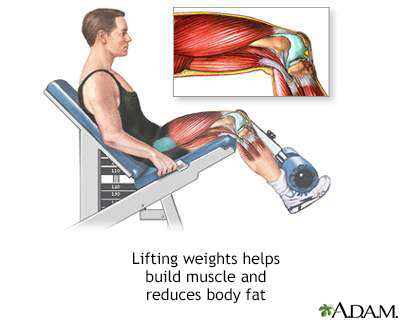Exercise, lifestyle, and your bones
Osteoporosis - exercise; Low bone density - exercise; Osteopenia - exercise

Weight lifting builds muscle, which increases overall body strength, tone, and balance. Muscles also burn calories more efficiently than fat and other body tissues. So even at rest the more muscle tissue a person has the more calories a person is burning.
Why Exercise?
Make exercise a regular part of your life. It helps keep your bones strong and lower your risk of osteoporosis and fractures as you get older.
Before you begin an exercise program, talk with your health care provider if:
- You are 50 years of age or older
- You have not been active for a while
- You have diabetes, heart disease, lung disease, or any other health condition
How Much and What Type of Exercise?
To build up bone density, the exercise must make your muscles pull on your bones. These are called weight-bearing exercises. Some of them are:
- Brisk walks, jogging, playing tennis, dancing, or other weight-bearing activities such as aerobics and other sports
- Careful weight training, using weight machines or free weights
Weight-bearing exercises also:
- Increase bone density even in young people
- Help preserve bone density in women who are approaching menopause
To protect your bones, do weight-bearing exercises 3 or more days a week for a total of over 90 minutes a week.
If you are older, check with your provider before doing high-impact aerobics, such as step aerobics. This type of exercise may increase your risk for fractures if you have osteoporosis.
Low-impact exercises, like yoga and tai chi, do not help bone density very much. But they can improve your balance and lower your risk of falling and breaking a bone. And, even though they are good for your heart, swimming and biking do not increase bone density.
Other Lifestyle Changes to Help Your Bones
If you smoke, quit. Also limit how much alcohol you drink. Too much alcohol can damage your bones and raise your risk of falling and breaking a bone.
If you do not get enough calcium, or if your body does not absorb enough calcium from the foods you eat, your body may not make enough new bone. Talk with your provider about calcium and your bones.
Vitamin D helps your body absorb enough calcium.
- Ask your provider if you should take a vitamin D supplement.
- You may need more vitamin D during the winter or if you need to avoid sun exposure to prevent skin cancer.
- Ask your provider about how much sun is safe for you.
References
Bone Health & Osteoporosis Foundation website. Healthy bones for life: patient's guide.
Bone Health and Osteoporosis Foundation. What is osteoporosis and what causes it?
De Paula FJA, Black DM, Miller PD, Rosen CJ. Osteoporosis: basic and clinical aspects. In: Melmed S, Auchus RJ, Goldfine AB, Rosen CJ, Kopp PA, eds. Williams Textbook of Endocrinology. 15th ed. Philadelphia, PA: Elsevier; 2025:chap 29.
LeBoff MS, Greenspan SL, Insogna KL, et al. The clinician's guide to prevention and treatment of osteoporosis. Osteoporos Int. 2022;33(10):2049-2102. PMID: 35478046
Version Info
Last reviewed on: 5/20/2024
Reviewed by: Jacob Berman, MD, MPH, Clinical Assistant Professor of Medicine, Division of General Internal Medicine, University of Washington School of Medicine, Seattle, WA. Also reviewed by David C. Dugdale, MD, Medical Director, Brenda Conaway, Editorial Director, and the A.D.A.M. Editorial team.
